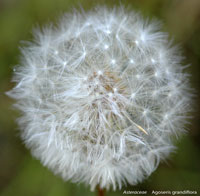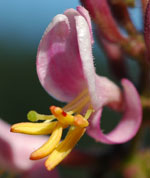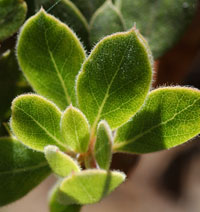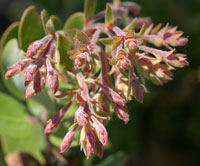A Journey Through the Scott Creek Watershed
 Schoolhouse Ridge
Schoolhouse Ridge
 We begin our ascent of the west-facing Schoolhouse Ridge complex, the area that is home to the type collection of the Santa Cruz clover
(Trifolium buckwestiorum).
Here the terraced benches are clothed and margined with stands of California oat grass (Danthonia californica), purple needlegrass (Stipa pulchra),
blue wild rye (Elymus glaucus subsp. glaucus), California brome (Bromus carinatus var. carinatus),
and California melic (Melica californica). These perennial grasses are punctuated with randomly dispersed colonies of cinnamon-scented owl's-clover
(Castilleja densiflora subsp. densiflora) and large-flowered agoseris (Agoseris grandiflora var. grandiflora),
its outsized seed heads simulating an aggregation of snowflakes.
We begin our ascent of the west-facing Schoolhouse Ridge complex, the area that is home to the type collection of the Santa Cruz clover
(Trifolium buckwestiorum).
Here the terraced benches are clothed and margined with stands of California oat grass (Danthonia californica), purple needlegrass (Stipa pulchra),
blue wild rye (Elymus glaucus subsp. glaucus), California brome (Bromus carinatus var. carinatus),
and California melic (Melica californica). These perennial grasses are punctuated with randomly dispersed colonies of cinnamon-scented owl's-clover
(Castilleja densiflora subsp. densiflora) and large-flowered agoseris (Agoseris grandiflora var. grandiflora),
its outsized seed heads simulating an aggregation of snowflakes.
 Following the Mill Creek side of the ridge, we see pipestems (Clematis lasiantha), hairy honeysuckle (Lonicera hispidula), California chicory
(Rafinesquia californica), twining snapdragon (Antirrhinum kelloggii), woolly malacothrix (Malacothrix floccifera), and stinging lupine
(Lupinus hirsutissimus). Also here is one of the most dynamic and taxonomically complicated burl-forming manzanita populations in the state, growing in
mudstone so weathered it has been reduced to powder-like fragments, reconfigured into miniature dunes reminiscent of a Zen garden.
Following the Mill Creek side of the ridge, we see pipestems (Clematis lasiantha), hairy honeysuckle (Lonicera hispidula), California chicory
(Rafinesquia californica), twining snapdragon (Antirrhinum kelloggii), woolly malacothrix (Malacothrix floccifera), and stinging lupine
(Lupinus hirsutissimus). Also here is one of the most dynamic and taxonomically complicated burl-forming manzanita populations in the state, growing in
mudstone so weathered it has been reduced to powder-like fragments, reconfigured into miniature dunes reminiscent of a Zen garden.
The Arctostaphylos crustacea Complex
 Articulating a plausible scenario for the current evolutionary status of the manzanitas found here is to enter into a scientific debate of gladiatorial proportions—but signposts, even flawed ones, are a navigational necessity in this ecological arena! The origins of the Arctostaphylos crustacea complex may be
polyphyletic—its burl is putatively derived from ancient hybridization between a horizontally aligned, nodal-rooting diploid species
(aff. A. uva-ursi) and a vertically aligned, auriculate-leaved diploid species (aff. A. andersonii). Subsequent reduction and coalescence of
Articulating a plausible scenario for the current evolutionary status of the manzanitas found here is to enter into a scientific debate of gladiatorial proportions—but signposts, even flawed ones, are a navigational necessity in this ecological arena! The origins of the Arctostaphylos crustacea complex may be
polyphyletic—its burl is putatively derived from ancient hybridization between a horizontally aligned, nodal-rooting diploid species
(aff. A. uva-ursi) and a vertically aligned, auriculate-leaved diploid species (aff. A. andersonii). Subsequent reduction and coalescence of
 the node-rooting axis may have occurred through selective evolutionary pressures imposed by seasonal fires and concurrent/subsequent assimilation of genetic
material from sympatric species, ultimately producing an exceedingly long-lived, fire-regenerative "genetic sponge." This is for me a biologically
sound theory and one worth investigating on molecular (DNA sites), ecological (specificity of fungal associates), and structural (examination of misplaced burls,
the possible result of incomplete dominance) grounds.
the node-rooting axis may have occurred through selective evolutionary pressures imposed by seasonal fires and concurrent/subsequent assimilation of genetic
material from sympatric species, ultimately producing an exceedingly long-lived, fire-regenerative "genetic sponge." This is for me a biologically
sound theory and one worth investigating on molecular (DNA sites), ecological (specificity of fungal associates), and structural (examination of misplaced burls,
the possible result of incomplete dominance) grounds.
All photographs © Dylan Neubauer
